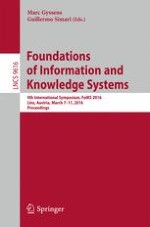2016 | Buch
Über dieses Buch
This book constitutes the proceedings of the 9th International Symposium on Foundations of Information and Knowledge Systems, FoIKS 2016, held in Linz, Austria, in March 2016. The 14 revised full papers presented papers were carefully reviewed and selected from 23 submissions. The papers address various topics such as reasoning about beliefs, uncertainty, incompleteness, and inconsistency, inference and problem solving, querying and pattern mining, dealing with knowledge, logics and complexity.
Anzeige
